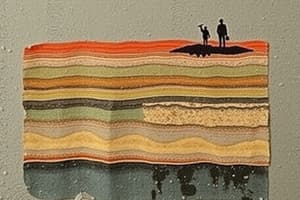Podcast
Questions and Answers
In order from closest to the surface to furthest inside Earth, what are the scientific names for the layers of Earth?
In order from closest to the surface to furthest inside Earth, what are the scientific names for the layers of Earth?
Lithosphere, asthenosphere, lower mantle, outer core, inner core
How is the lithosphere different from the crust?
How is the lithosphere different from the crust?
The lithosphere is the crust and part of the upper mantle. The crust does not include the upper mantle.
What is the relationship between the lithosphere and the asthenosphere?
What is the relationship between the lithosphere and the asthenosphere?
The lithosphere sits on top of the asthenosphere and is moved around via convection currents.
What is the asthenosphere made of?
What is the asthenosphere made of?
How do we know what the inside of Earth looks like?
How do we know what the inside of Earth looks like?
Where do seismic waves come from?
Where do seismic waves come from?
What is the difference between the inner and outer core?
What is the difference between the inner and outer core?
What are 3 ways P and S waves are different?
What are 3 ways P and S waves are different?
Which piece of evidence for continental drift and plate tectonics came first?
Which piece of evidence for continental drift and plate tectonics came first?
What happens at subduction zones?
What happens at subduction zones?
What happens at areas of sea-floor spreading?
What happens at areas of sea-floor spreading?
Why does the sea-floor show magnetic striping?
Why does the sea-floor show magnetic striping?
What is the epicenter of an earthquake?
What is the epicenter of an earthquake?
What happens when oceanic and continental crust meet?
What happens when oceanic and continental crust meet?
What is the newest continent?
What is the newest continent?
What are some characteristics of a continent?
What are some characteristics of a continent?
What is the mantle?
What is the mantle?
What is the lithosphere?
What is the lithosphere?
What are P-waves?
What are P-waves?
What types of volcanoes are there?
What types of volcanoes are there?
What is plate tectonics?
What is plate tectonics?
What is density?
What is density?
What is the crust?
What is the crust?
What is the outer core?
What is the outer core?
What is the asthenosphere?
What is the asthenosphere?
Flashcards are hidden until you start studying
Study Notes
Earth's Layers
- Layers of Earth from surface to center: lithosphere, asthenosphere, lower mantle, outer core, inner core.
- Lithosphere includes the crust and part of the upper mantle, whereas the crust is solely the outer layer.
Lithosphere and Asthenosphere Relationship
- Lithosphere floats on the asthenosphere, allowing for movement due to convection currents.
- Asthenosphere consists of nearly melted rock with a plastic consistency, enabling lithospheric mobility.
Seismic Waves and Earth's Interior
- Seismic waves, generated primarily by earthquakes and volcanoes, provide insights into Earth's internal structure.
- Inner core is solid (nickel and iron), while outer core is liquid but composed of the same metals.
Properties of P and S Waves
- P waves are faster than S waves and can travel through fluids, while S waves cannot.
- P waves move in the same direction as the force, whereas S waves move perpendicular to the force direction.
Evidence for Continental Drift
- Fit of continents is a key observation supporting continental drift theories, indicating prior positions of landmasses.
Plate Interactions
- Subduction zones occur where two tectonic plates collide; the denser oceanic plate sinks beneath the continental plate.
- Seafloor spreading happens at divergent boundaries, creating new oceanic crust from rising magma.
Magnetic Striping
- Magnetic striping on the ocean floor results from periodic reversals of Earth's magnetic poles that affect new crust formation.
Earthquake Dynamics
- Epicenter is the point on Earth’s surface directly above the origin of an earthquake.
Oceanic vs Continental Crust
- At the convergence of oceanic and continental crust, the oceanic plate is subducted due to its higher density.
Zealandia as the Newest Continent
- Zealandia is recognized as the newest continent based on geological criteria.
Definition of a Continent
- A continent is characterized by distinct elevation, geology, defined area, and thicker crust than the ocean floor.
The Mantle's Role
- The mantle, or asthenosphere, consists of malleable magma facilitating plate movements through convection currents.
Tectonic Plates
- Lithosphere comprises the tectonic plates, integrating crust and the uppermost mantle.
Types of Volcanoes
- Volcanoes vary in explosiveness; types include shield, cinder cone, and composite.
- Lava classifications: pahoehoe, aa, blocky, and pillow lava.
Fossils in Plate Tectonics
- Fossil evidence identifies the presence of similar organisms across continents, supporting plate tectonic theories.
Density Definition
- Density represents the mass contained in a specific volume, a critical property in geological studies.
Crust Composition
- The crust is a component of the lithosphere, alongside the uppermost mantle, forming tectonic plates.
Outer Core Characteristics
- The outer core is a liquid layer composed of iron and nickel, contributing to Earth's magnetic field.
Summary of Properties of Asthenosphere
- Also referred to as the mantle, it resides beneath the lithosphere, characterized by soft, flowing magma and convection currents that drive tectonic plate movement.
Studying That Suits You
Use AI to generate personalized quizzes and flashcards to suit your learning preferences.




